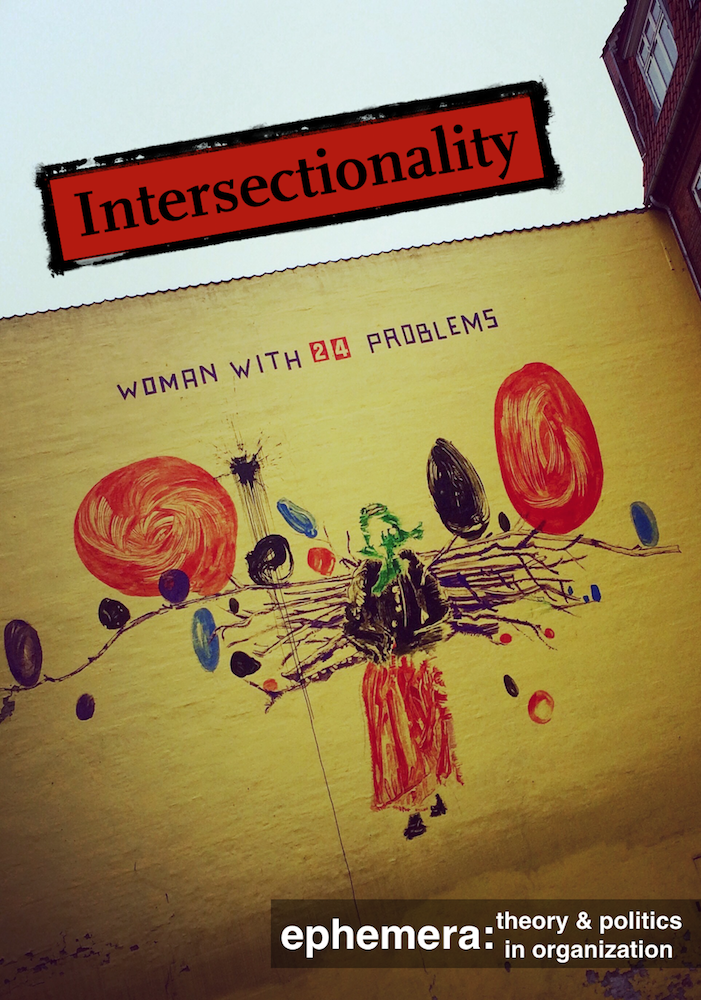Ephemera, 18(1): Intersectionality (2018)
Filed under journal | Tags: · feminism, intersectionality, metoo, power, race

“The continued interest in intersectionality can be seen as a positive sign that feminist-inspired scholarship still has something significant to offer, and that its political dimension lives on. In management and organization studies, Intersectionality has been seized either as a theoretical lens or methodological approach in a number of literature strands, in both conceptual and empirical work. Yet, it would be too hasty to conclude that intersectionality is the answer to all ills, or the panacea that can replace the use of the ‘f-word’ altogether. This special issue addresses a number of tensions and contention points in intersectionality research. We formulate them as follows: i. a tension between seeing intersectionality as a bounded vs. polymorphous concept; ii. a tension between intersections as stable vs. fluid; iii. a tension between intersectional thinking as a tool to apprehend embodied experiences vs. as a possible limitation to a universal democratic and emancipatory project. The aim of our special issue is thus not to take sides in these ongoing discussions, but rather to see what intersectionality can ‘do’ for organization studies at large. Authors in this special issue address, at times passionately, one or the other side of these arguments.”
Edited by Florence Villesèche, Sara Louise Muhr, and Martyna Śliwa
Publisher Ephemera collective, with MayFlyBooks, Feb 2018
Creative Commons Attribution-Noncommercial-No Derivative Works 3.0 Unported License
ISBN 9781906948405
227 pages
Media-N, 12(3): Uncovering News: Reporting and Forms of New Media Art (2017)
Filed under journal | Tags: · aesthetics, art, art criticism, fake news, journalism, media activism, media art, new media art, propaganda, reality, tactical media, truth

“As the highly contested term “fake news” has become omnipresent in our media sphere and as the hacking of private networks for political gain have dominated the global news cycle, Media-N’s new issue is well positioned to uncover the complex relationship between media art and the multifarious forms of news reportage. We find in this wide-ranging journal issue, new media artists, writers, and theoreticians attempting to reveal, expose, and protest the production, rhetoric, and dissemination of news. Exploiting or subverting the existing network or creating alternative technologies, codes, or platforms, new media artists has probed the hegemonic grip of tradition forms of media production. Employing the raw material of journalism or intervening in the distribution and transmission of news information, artists have effectively critiqued or reimagined the unstable and fluid spaces of the contemporary news sphere. The nature of news information and its relationship to concepts of reality, truth, aesthetics, and the public and private are all at play in this issue.” (from Introduction)
With contributions by Erica Levin, Randall Packer, Kris Paulsen, Erin McElroy, Lisa Moren, Brandon Bauer, Rick Valentin, Francesca Franco, Yasuhito Abe, Vincent Cellucci, Jesse Allison, Derick Ostrenko, and Mina Cheon.
Guest editors: Abigail Susik and Grant Taylor
Publisher New Media Caucus, 2017
Open Access
ISSN 1942-017X
Computational Culture, 6: Computing the Corporeal / Geographies of Software (2017)
Filed under journal | Tags: · body, computation, computing, dance, geography, movement, movement computing, software, software studies
This issue of Computational Culture consists of two thematic sections. The section “Computing the Corporeal” is concerned with the critique of “the way in which machine computers affect movement-based creativity, and movement-based thinking.” The section “Geographies of Software” presents “geographical approaches to software studies.”
With thematic texts by John Stell, Stamatia Portanova, Scott delaHunta, Anton Koch (section 1), Will Payne, Warren Sack, and Pip Thornton (section 2), editorial introductions, and review section.
Section “Computing the Corporeal” edited by Nicolas Salazar Sutil and Scott delaHunta
Section “Geographies of Software” edited by Nick Lally and Ryan Burns
Published in November 2017
Open Access
ISSN 2047-2390

